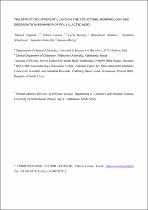 ResearchSpace
ResearchSpace
The effect of different clays on the structure, morphology and degradation behavior of poly(lactic acid)
JavaScript is disabled for your browser. Some features of this site may not work without it.
- ResearchSpace
- →
- Research Publications/Outputs
- →
- Journal Articles
- →
- View Item
| dc.contributor.author |
Neppalli, R

|
|
| dc.contributor.author |
Causin, V

|
|
| dc.contributor.author |
Marega, C

|
|
| dc.contributor.author |
Modesti, M

|
|
| dc.contributor.author |
Adhikari, R

|
|
| dc.contributor.author |
Scholtyssek, S

|
|
| dc.contributor.author |
Ray, Suprakas S

|
|
| dc.contributor.author |
Marigo, A

|
|
| dc.date.accessioned | 2014-09-11T06:45:30Z | |
| dc.date.available | 2014-09-11T06:45:30Z | |
| dc.date.issued | 2014-01 | |
| dc.identifier.citation | Neppalli, R. et al. 2014. The effect of different clays on the structure, morphology and degradation behavior of poly(lactic acid). Applied Clay Science, vol. 87, pp 278- 284 | en_US |
| dc.identifier.issn | 0169-1317 | |
| dc.identifier.uri | http://ac.els-cdn.com/S0169131713003980/1-s2.0-S0169131713003980-main.pdf?_tid=76c4cf96-34fd-11e4-ae47-00000aab0f6c&acdnat=1409922575_8b97eb81dea77d5db998ebe8e95a3828 | |
| dc.identifier.uri | http://hdl.handle.net/10204/7660 | |
| dc.description | Copyright: 2014 Elsevier. This is the pre/post print. The definition version is published in Applied Clay Science, vol. 87, pp 278-284 | en_US |
| dc.description.abstract | In this work, polylactic acid (PLA)-based nanocomposites filled with different kinds of clay were prepared and their structure, morphology and degradation behavior were compared. A similar degree of dispersion was achieved in the case of cationic and anionic clays. However, these two types of fillers had different effects on the structure and morphology. Perkalite, an anionic clay, induced higher crystallinity, a faster crystallization rate and also a modification of the crystallization mechanism. Moreover, when perkalite was used, the lamellar framework of PLA was preserved. Cationic clays, on the other hand, were detrimental for a regular crystallization of the PLA matrix, producing very disordered lamellar stacks. The effects of anionic and cationic clays were different also on the degradation behavior, with the perkalite-containing nanocomposite degrading much faster than either the matrix or the montmorillonite-reinforced materials. This comparison shows that a rational choice of the chemical nature of the nanofiller allows to tune both the degradation rate of PLA and its structure. | en_US |
| dc.language.iso | en | en_US |
| dc.publisher | Elsevier | en_US |
| dc.relation.ispartofseries | Workflow;13397 | |
| dc.subject | Montmorillonite | en_US |
| dc.subject | Perkalite | en_US |
| dc.subject | Layered double hydroxide | en_US |
| dc.subject | Clay polymer nanocomposites (CP) | en_US |
| dc.subject | Polylactid | en_US |
| dc.subject | Poly(lactic acid) | en_US |
| dc.title | The effect of different clays on the structure, morphology and degradation behavior of poly(lactic acid) | en_US |
| dc.type | Article | en_US |
| dc.identifier.apacitation | Neppalli, R., Causin, V., Marega, C., Modesti, M., Adhikari, R., Scholtyssek, S., ... Marigo, A. (2014). The effect of different clays on the structure, morphology and degradation behavior of poly(lactic acid). http://hdl.handle.net/10204/7660 | en_ZA |
| dc.identifier.chicagocitation | Neppalli, R, V Causin, C Marega, M Modesti, R Adhikari, S Scholtyssek, Suprakas S Ray, and A Marigo "The effect of different clays on the structure, morphology and degradation behavior of poly(lactic acid)." (2014) http://hdl.handle.net/10204/7660 | en_ZA |
| dc.identifier.vancouvercitation | Neppalli R, Causin V, Marega C, Modesti M, Adhikari R, Scholtyssek S, et al. The effect of different clays on the structure, morphology and degradation behavior of poly(lactic acid). 2014; http://hdl.handle.net/10204/7660. | en_ZA |
| dc.identifier.ris | TY - Article AU - Neppalli, R AU - Causin, V AU - Marega, C AU - Modesti, M AU - Adhikari, R AU - Scholtyssek, S AU - Ray, Suprakas S AU - Marigo, A AB - In this work, polylactic acid (PLA)-based nanocomposites filled with different kinds of clay were prepared and their structure, morphology and degradation behavior were compared. A similar degree of dispersion was achieved in the case of cationic and anionic clays. However, these two types of fillers had different effects on the structure and morphology. Perkalite, an anionic clay, induced higher crystallinity, a faster crystallization rate and also a modification of the crystallization mechanism. Moreover, when perkalite was used, the lamellar framework of PLA was preserved. Cationic clays, on the other hand, were detrimental for a regular crystallization of the PLA matrix, producing very disordered lamellar stacks. The effects of anionic and cationic clays were different also on the degradation behavior, with the perkalite-containing nanocomposite degrading much faster than either the matrix or the montmorillonite-reinforced materials. This comparison shows that a rational choice of the chemical nature of the nanofiller allows to tune both the degradation rate of PLA and its structure. DA - 2014-01 DB - ResearchSpace DP - CSIR KW - Montmorillonite KW - Perkalite KW - Layered double hydroxide KW - Clay polymer nanocomposites (CP) KW - Polylactid KW - Poly(lactic acid) LK - https://researchspace.csir.co.za PY - 2014 SM - 0169-1317 T1 - The effect of different clays on the structure, morphology and degradation behavior of poly(lactic acid) TI - The effect of different clays on the structure, morphology and degradation behavior of poly(lactic acid) UR - http://hdl.handle.net/10204/7660 ER - | en_ZA |





